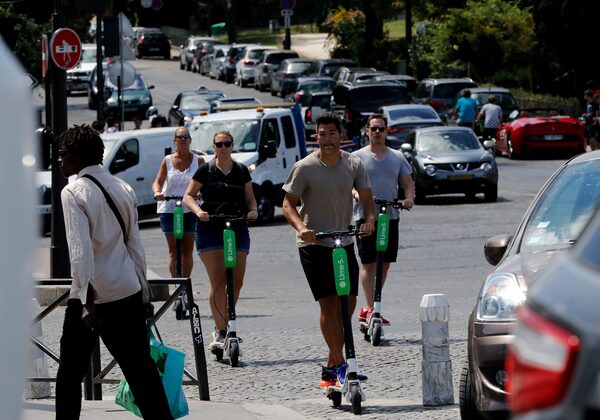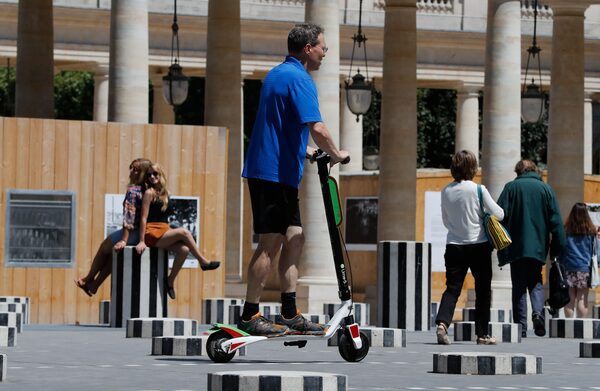Tray Graham’s vehicle for getting around town might once have passed for a kid’s toy. Instead, it’s part of a whirring wave challenging views about urban transportation in Atlanta.
“It’s very addictive, and it gets you where you want to be,” Graham said after a ride on his rented stand-up electric scooter, a contraption that’s making city politicians fret and urban planners dream.
Atlanta, one of the first cities where the Uber ride-hailing app launched several years ago, is now hot turf for rentable on-demand mini electric vehicles. The trend brings alternatives to traditional commuting but introduces new challenges and questions about whether it will have wide and sustainable appeal.

People use electric scooters of the U.S. company Lime in Paris on July 9, 2018.FRANCOIS GUILLOT/Getty Images
In May, California-based Bird launched in Midtown, Little Five Points, downtown and Virginia-Highland with what look Razor scooters, though with hidden motors and bigger wheels. Riders stand on a narrow deck.
Then came Muving Ecosystem, based in Spain, which made Atlanta its U.S. base and the first American market for its yellow rental mopeds similar to Vespas. They require operators to have drivers’ licences and to wear provided helmets. The company said it may add three-wheel electric vehicles later this year.
Ofo, out of China, has entered Atlanta with pedal-powered bicycles and hopes to add motorized scooters and electric-powered bicycles in the fall. California-based Lime is offering stand-up electric scooters, charging $1 to unlock them and 15 cents for each minute of riding. The company said it hopes to add local bicycles, including electric versions.
And Uber, the early commuting disruptor, has talked to Atlanta officials about possibly adding its Jump rental electric bicycles to the market.
The entrants are the nimble private sector’s attempt to profit on solutions for traffic-clogged city streets. (They’ve shown less interest in gridlocked but less densely developed suburbs.)
Already, they’ve put dibs on public real estate. That means pushing cities to clarify how sidewalks may be used and whether the fleets of devices can be parked there for free.
The new companies also could join bicycle fans in urging reconfiguration of additional in-town streets to safely handle 48 km/h electric mopeds, stand-up scooters that go 24 km/h on flat ground, pedal-assist electric bicycles and, potentially, three-wheeled transports with seat belts. Adding these new options to busy roads is risky, to say nothing of new operators who don’t wear helmets.
“The technology of travel and travel behaviors are changing so rapidly and in so many directions that in some ways, all bets are off,” as far as picking which will thrive, said Michael Dobbins, a Georgia Tech professor specializing in urban planning. “It could be pretty exciting. It could be really scary.”

A man uses an Electric scooter of the US company Lime at the Colonnes de Buren (Les Deux Plateaux), an art installation created by the French artist Daniel Buren, in the inner courtyard of the Palais Royal in Paris on July 9, 2018.FRANCOIS GUILLOT/Getty Images
The rentals are designed to be booked with apps similar to Uber or its competitor, Lyft. They also can be unlocked and locked that way. Unlike the city of Atlanta’s Relay Bike Share program, they can be picked up and dropped off at random locations instead of at centralized docking stations.
Generally, it appears the new devices are supposed to stick to streets when in motion. While city officials are trying to get things clarified, companies say their motorized vehicles aren’t supposed to be driven on the Atlanta Beltline or local sidewalks, except when they are being parked.
But plenty of the devices have been spotted where they aren’t allowed, although enforcement doesn’t seem robust.
State law does allow the grandpas of the breed – Segways – on sidewalks, although only at limited speeds. Segways, which never reached the broad public adoption boosters initially predicted, aren’t the model new rivals are looking to replicate.
But, as with Segways, the newcomers are focused on relatively short rides – less than three kilometres for the stand-up scooters or about six kilometres for the sit-down variety. That would cover more than half the kilometres driven in private vehicles in the United States.
GPS and remote unlocking technology allow the competitors to launch without docking stations. That makes their rollouts faster and limits up-front costs (about US$300 for a standard bicycle or US$500 for a motorized stand-up scooter versus about US$3,000 for each if factoring in docking costs, according to one provider).
Rollouts elsewhere have gone less than flawlessly. Riders around the U.S. have left scooters in the middle of sidewalks and propped up on buildings or buzzed pedestrians rather than sticking to streets. The cities of San Francisco, Denver, Nashville and Indianapolis have impounded scooters or pushed for temporary service suspensions.
In Atlanta, city councilmembers have drafted a proposed ordinance, including limits on fleet size, the number of devices parked on any city block and requiring providers to station some devices in farther-out areas.
“If someone along Campbellton Road wants to use one, they should have them easily accessible,” council member Dustin Hillis said.
Bird and Lime have said they will collect their vehicles every night to be recharged and redistributed. And Bird has pledged to give cities US$1 for every scooter every day it’s in use, with the money earmarked for rider safety or similar efforts.
Some activists are wary.

Children use electric scooters of the U.S. company Lime in Paris on July 9, 2018, as they ride on a work from French street artist Seth.FRANCOIS GUILLOT/Getty Images
“There is no code of behavior for people on these scooters,” said Sally Flocks, the chief executive of PEDS, a Georgia pedestrian advocacy group.
She said dedicated street lanes might be the right place for scooters and such, but that’s just the kind of move that might frustrate drivers already stewing in traffic.
Muving CEO Ivan Contreras, who has stationed rental mopeds around Atlanta, sees the market continuing to evolve.
“Like all the things that are new, there will be restrictions at the beginning, but in the end it will be a solution,” he said.
Catherine Anderson, who lives and works intown, is sold on renting Bird scooters.
Never mind that she had to walk several blocks to find an accessible one recently. Or that she dealt with heat, drizzle and one “dicey” ride along busy roads. A return ride to Midtown from lunch at Ponce City Market covered nearly three kilometres, lasted 15 minutes and cost $3.25.
“It’s got a freeing feel to it,” she said.
“I just don’t want to get in my car that much. … Atlanta drivers are not as hospitable as they use to be.”
New York Times
This content appears as provided to The Globe by the originating wire service. It has not been edited by Globe staff.